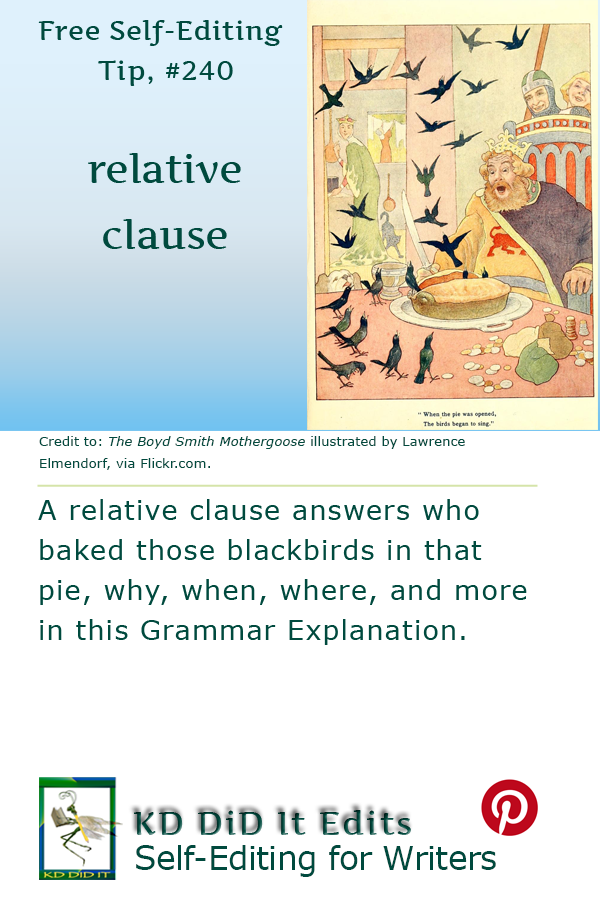Revised as of
29 Jan 2023
Essentially, a relative clause acts as an adjective* to answer questions like What kind?, How many?, Who?, or Which one?, etc. Starting with a relative pronoun or relative adverb, the relative clause itself is a dependent clause with its own subject and verb.
* It’s why the relative clause is also referred to as the adjective or adjectival clause.
Grammar Explanations is . . .
. . . an evolving list of the structural rules and principles that determines where words are placed in phrases or sentences as well as how the language is spoken. Sometimes I run across an example that helps explain better or another “also known as”. Heck, there’s always a better way to explain it, so if it makes quicker and/or better sense, I would appreciate suggestions and comments from anyone on an area of grammar with which you struggle or on which you can contribute more understanding.
If you found this post on “Relative Clause” interesting, consider subscribing to KD Did It, if you’d like to track this post for future updates.
| Relative Clause | |||
| Definition: A type of dependent clause with its own subject + verb that is connected to the independent clause of the sentence by a relative pronoun or a relative adverb to answer the questions of what, who, how many, etc.
NOTE: The subject in a relative clause sometimes is the relative pronoun or relative adverb. POST CONTENTS A.k.a., adjective clause, adjectival clause |
|||
| Using a Relative Adverb | Rule: Introduces a relative clause with a relative adverb that answers the how, that, where, when, why, etc.
Click for a list of relative adverbs. |
||
|
Return to top or post contents |
Legend:
We tried our luck at the same flea market where George found Amazing Spider-Man #96 in fair condition. Michelle screamed when she saw the spider that dangled from the one clean bathroom towel. |
||
| Using a Relative Pronoun | Rule: Introduces a relative clause with a relative pronoun that answers the what, which, who, etc.
Click for a list of relative pronouns. |
||
|
Return to top or post contents |
Legend:
To calm his angry girlfriend, Joey offered an apology which Francine did not accept. Brian said goodnight to his roommate Justin, who continued to play video games until his eyes were blurry with fatigue. |
||
| Comma Rules for the Relative Clause | |||
| The rules for essential and non-essential apply to relative clauses. You may also want to check out identifiers with its restrictive and nonrestrictive rules. | |||
| Essential Restrictive Defining |
Nonessential Nonrestrictive Nondefining |
||
|---|---|---|---|
| General Rule: Whether a comma(s) is required depends on if the clause is essential or nonessential. And either an essential or nonessential clause may interrupt a sentence. | |||
| Definition: The subject word used is nonspecific and the relative clause provides more information so we know which ones are being discussed. | Definition: Uses a specific subject, which makes the relative clause nonessential and commas must be used to separate it from the primary sentence.
Not being essential to the meaning of the sentence, the clause can be removed from the sentence without changing its basic meaning. A good indicator that you need to use commas. |
||
| Rule: Use a comma if the essential clause is introductory. Don’t use a comma when the clause follows the main clause or interrupts it. | Rule: Because the clause is nonessential, commas are required to connect them to the sentence.
Punctuation differs depending upon where the clause appears in the sentence:
|
||
| The suspect in the lineup who has red hair committed the crime.
Suspect is in the the lineup AND has red hair. |
The suspect in the lineup, who owns a red car, committed the crime.
Suspect is in the lineup and owns a red car AND there may be other suspects in the lineup who have red cars. |
||
| The boat that sailed on October 25 is the one to which we referred in the contract. | Mrs. Horscht, who used to be a model, is a very beautiful woman. | ||
| She gave a treat to the cats who were sitting at her feet. | She gave a treat to Muffin and Petey, who were sitting at her feet. | ||
| The guys who race in the street seem especially noisy later in the evening. | Hank and his friend Jamie, who race in the street, seem especially noisy later in the evening. | ||
| Interrupting: After dripping mustard all over his chest, the man who was wearing a red shirt wished that he had chosen ketchup for his hotdog instead. |
Interrupting: After dripping mustard all over his chest, Charles, who was wearing a red shirt, wished that he had chosen ketchup for his hotdog instead. Legend:
|
||
C’mon, get it out of your system, bitch, whine, moan . . . which words are your pet peeves? Also, please note that I try to be as accurate as I can, but mistakes happen or I miss something. Email me if you find errors, so I can fix them . . . and we’ll all benefit!
Satisfy your curiosity about other Grammar Explanations by exploring its homepage or more generally explore the index of self-editing posts. You may also want to explore Book Layout & Formatting Ideas, Formatting Tips, Grammar Explanations, Linguistics, Publishing Tips, the Properly Punctuated, Word Confusions, Writing Ideas and Resources, and Working Your Website.
Resources for Relative Clause
“Clauses – Restrictive and Nonrestrictive.” Kent Law. n.d. Web. n.d. <http://www.kentlaw.edu/academics/lrw/grinker/LwtaClauses__Restrictive_and_Nonrest.htm>.
GrammarBook.com
Simmons, Robin L. “The Relative Clause.” Chomp Chomp. n.d. Web. n.d. <http://www.chompchomp.com/terms/relativeclause.htm>.
⸻ ⸻ ⸻. “The Subordinate Clause.” Chomp Chomp. n.d. Web. n.d. <https://chompchomp.com/terms/subordinateclause.htm>.
Pinterest Photo Credits
The Boyd Smith Mothergoose illustrated by Lawrence Elmendorf, via Flickr.com.


